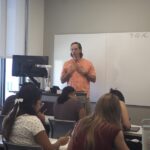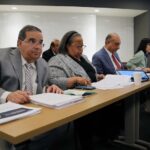Texas A&M-San Antonio opened its first permanent building to 3,500 students in 2011, but the first settlers inhabited the land in South San Antonio centuries ago.
As the campus faces continual pressure to think about the future, history faculty, university leaders, and local organizations teamed together recently to think about and commemorate the past.
University President Cynthia Teniente-Matson and Virginia S. Nicholas, commission chair of Bexar County Historical Commission, unveiled a historical marker on Sep. 22 acknowledging the historical importance of the 694 acres where the university was established and continues to grow.
“The more that has been revealed by historians about the previous inhabitants of this land, the stronger our community foundation becomes,” Matson said.
Rey Hernandez, a descendent of early settlers of the land where campus now sits, said he was thankful to have his ancestors recognized with a historical marker.
“I take it with great honor and humbleness to know that our people and the families are being recognized for their contributions,” Hernandez said proudly.
“We’ve come together to celebrate the recognition of the deeply rooted history of the land where our university is now housed,” Matson said during the dedication ceremony.
Collective efforts from Bexar County Historical Commission, Texas Historical Commission, the Texas Connection to the American Revolution Association (TCARA), A&M-San Antonio faculty members, and former university President Dr. Maria Hernandez-Ferrier made the process for the historical marker possible.
Robert Thonhoff, TCARA Historian and history buff Rueben Perez suggested a historical marker be placed on the land.
TCARA is a non-profit educational organization dedicated to preserving and promoting unbiased Texas and American history for the public.
Thonhoff said it was important for students to have an understanding of the land’s historical significance.
Texas A&M-San Antonio history professors, Francis Galan and Amy Porter, served as advisors for the historical marker.
In partnership with TCARA, the historical marker committee submitted a 5-page narrative of the history of the land following in-depth research. The committee then submitted an application for a historical marker.
Once reviewed and accepted by the Texas Historical Commission, the commission composed the historical marker.
Cultural and historical importance
During the ceremony, Porter presented the historical background on the land.
When Spanish explorers arrived, early indigenous settlers, including the Coahuiltecans, lived in the southern Texas region and interacted with the Spaniards.
Missions were established by the Spanish explorers hoping to convert the indigenous peoples and incorporate them to the Spanish empire.
Mission ranch land had pasturage and live cattle that roamed freely.
In 1808, Juan Ignacio Perez received one of the largest Spanish land grants and acquired acres of land on both sides of the Medina River.
Fernando Rodriguez, son-in-law of Ignacio Perez, received a large portion of the Spanish land grant where the university sits today.

Another story told on the marker explains Spain’s role in the American Revolution.
Spain, which hadn’t declared themselves allies of Great Britain, declared war on the country while giving funds and supplies to British colonies.
Mission ranchers and farmers sent cattle to General Bernardo Del Galvez to support Spain in the American Revolution.
“My hope is that people will read this marker and will want to know more about local history, Spanish borderlands history, indigenous history, Spain’s role in the American Revolution and so much more,” Porter said.
The historical marker is intended to connect students, faculty, staff, and visitors to the history of the land.
In a recent podcast interview with Jaguar Student Media, university President Cynthia Teniente-Matson shared her insight on the importance of the historical marker for campus.
“We’ve been discovering more about our history as we think about our future,” Matson said. “We are remaining true to our heritage.”
Following the unveiling of the historical marker, Linda Ximenes, member of the Coahuiltecan Nation, performed a traditional offering to each of the four cardinal directions to acknowledge the gifts.
Dr. Andres Tijerina, a Texas A&M-College Station alumni and fellow of the Texas Historical Commission, spoke in the auditorium after the unveiling of the marker and discussed Spanish and Mexican land grants.
Tijerina published two books, “Tejano Empire: Life on the South Texas Ranchos,” and “Tejanos and Texas Under the Mexican Flag,” both published by Texas A&M University Press.
“A&M-San Antonio will always remain true to the heritage culture that was established here centuries ago. As we [the university] continue to grow, there will continue to be a strong effort to keep a strong connection to the heritage of our land,” Matson said.





